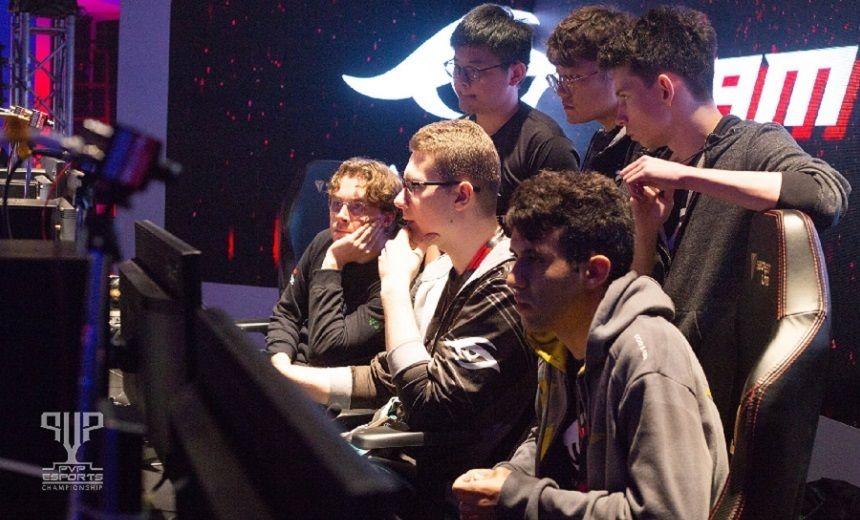
Team Secret at the PVP Esports Championships in Singapore; photo credit to PVP Esports
There’s a necessary lull between DPC qualifiers and their respective LAN events as teams need to secure their visas. Fortunately, there’s lots of competitive Dota 2 to keep us occupied, with smaller tournaments layered on top of each other. The biggest non-DPC event currently announced, ESL One Hamburg 2018 with a $300,000 (US) prize pool, is coming up in a few weeks, but before then there’s many other tournaments to watch.
The PVP Esports Championship, worth $200,000 (US), wrapped up on October 7. Maincast Autumn Brawl with its $80,000 (US) prize pool began on October 6 and runs through the 14th. World Showdown of Esports (WSOE) just announced a $100,000 (US) tournament to be held in Las Vegas from October 14-15. And Beyond the Summit is running their King’s Cup with North American and Southeast Asian editions. The winners of each of those will receive invitations to the Summit X in December and are guaranteed a share of that event’s $100,000 (US) prize pool.
There are also many other regional tournaments with smaller prize pools happening across the world.
Though there’s less pressure for teams to attend these events, because they won’t directly contribute to earning invites to The International 9 (TI9), the schedule is still very full.
The Positives
So, what’s great about these events?
Well, we have more opportunities to see our favorite teams. We’ve seen a huge range of teams participating in these events from popular standbys like Team Secret and PSG.LGD to newly established teams like Team Admiral and Happy Guys. It’s a pleasant mix for fans who aren’t committed to a single team—if you’re a fan of OG…well, surely they’ll announce their competitive intentions sooner or later, right?
Newer team rosters are getting valuable competitive experience, including LAN experience as in WSOE 1 and PVP Esports Championships. This DPC season, rosters are not penalized for breaking up and reforming until they attend DPC LANs and earn points. Therefore, teams that compete in non-DPC events have opportunities to see how well they perform in competitive environments on and offline, allowing those players to make informed decisions about committing to a roster for the season.
These events are also a source of income for some teams, particularly those with smaller organizations or who lack organizations and sponsors to support them. These tournaments also provide valuable exposure for lower tier or newer teams, giving fans a chance to connect with their brand and get hooked on the team’s story early in the season.
Finally, with so many of these events dominated by a specific region, we can watch some rivalries develop before the next set of DPC Regional Qualifiers. Building up these storylines heightens the enjoyment, for me at least, as I become more invested not only in the teams but in specific match-ups between teams.
A grey area, not great but not necessarily bad either, is that there’ve been several stand-ins for teams at these events. For various reasons, players have taken time out, giving us the opportunity to see some other players temporarily step into rosters they’d otherwise not play with. The downside of this is that we’re not always seeing what the full roster is capable of, which can make it complicated to gauge their performance potential.
However, the stand-ins are also creating some exciting viewing opportunities. Probably the most hype stand-in situation is that of Danil “Dendi” Ishutin standing in for Yeik “MidOne” Nai Zheng of Team Secret for the upcoming Maincast Autumn Brawl games. Significantly, this means Dendi reunites with former teammate Clement “Puppey” Ivanov, something we’ve not seen since Puppey left Natus Vincere in August 2014.
The Less Positives
The biggest concern I have about all these events is this: are teams pushing themselves too much?
The one thing that players seemed to agree about regarding the previous DPC season is that the schedule was too grueling. Everyone wanted to make it to as many DPC events as they could, which for many teams meant enduring exhausting weeks of qualifiers potentially followed by weeks away from home to attend events. Even those teams who received direct invites to events were still fatigued by the rigorous travel required to attend tournaments.
Online tournaments reduce the travel concerns, but overly full schedules are still alarming. Hopefully players are making conscious choices about which tournaments they try to qualify for or accept invitations to compete in.
These smaller tournaments do tend to have invitations rather than full qualifiers as the DPC events are required to, which means there’s some preferential treatment. Tournament organizers want teams to attend who will draw the most viewers, of course, but hopefully lesser known/newer teams are being treated fairly. Fortunately, many of these events have had some portion of their invitations given out through qualifiers, providing opportunities to lower tier teams.
As a fan, the biggest issue these events are causing for me is working out a personal schedule for which games to watch each day! If you’re struggling to keep up, check out the GosuGamers’ Dota 2 match ticker, which will give you an idea of the plethora of games you can choose from each day. My strategy right now has been to choose an event to follow and rely on social media and news articles to keep me informed about what’s happening elsewhere in the Dota-sphere.
Are you enjoying all the events happening right now? Are you satisfied by how many non-DPC events have stepped up to fill the schedule? Is there enough at stake at these events to keep you engaged and invested? Tell me in the comments what you think about these early weeks of the DPC Season 2 featuring so many non-DPC tournaments!







